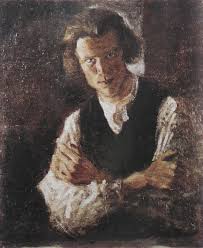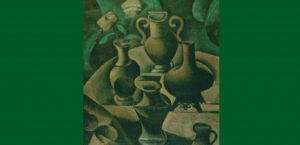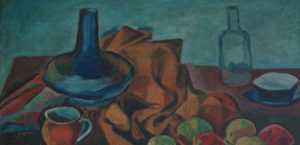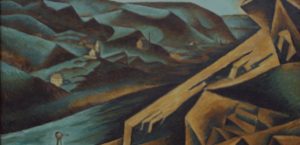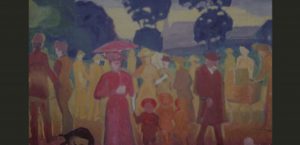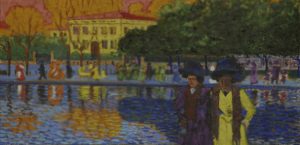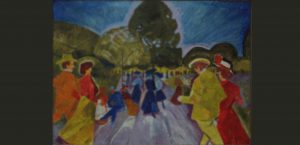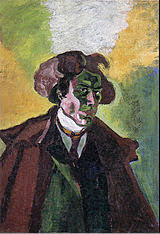Bohumil Kubista was born on the 21st of August in 1884 in the village of Vlčkovice, near the Czech major city of Hradec Králové.
1884 - 1918
Bohumil Kubista

description
A Czech avant-garde artist. He was an active member of the Czech association “Eight” (“Osma”) and the organizer of the first Prague exhibition “Independent”, and also became a member of the group of the first German Expressionists “Bridge” (Die Brücke, Dresden, then Berlin) and Berlin’s “New Secession”.
Bohumil was born and raised into a poor family. In 1896-1905, he studied at a real school, where he discovered a great mathematical ability. After graduation, he entered the Art and Industrial School (the School of Applied Arts) in Prague, which he left because of the conflict with the teacher. Then he intended to continue his studies at the Prague Academy of Fine Arts, although was completely dissatisfied with the classical teaching system. He left this educational institution, went to work in the army for money. The appearance of Kubista as a painter was influenced by E. Munch’s exhibition, which he once visited.
The artist’s works are an adornment of the collections of many Czech galleries and museums. The works of Bohumil Kubista had a significant impact on the formation of the national avant-garde in its various manifestations, the painting of a young generation of artists of the period between world wars and the creative youth of the 1960s of the 20th century.
Despite the fact that the entire creative career of Bohumil Kubista covers ten years, it is impossible to imagine the creation and development of the national Czech avant-garde painting without him. His work contributed to the spread of various theories of art in the Czech Republic, bringing it closer to the level of world achievements. Being not only a talented and original artist, B. Kubista said his word and in a European scale – the synthesis of art used by him is called a special “expressionistic cubism”. The first Prague exhibitions of “independent” artists, who formed opposition to Academism, were held thanks to the active participation of Bohumil Kubista, an energetic organizer and uncompromising champion of contemporary art in their preparation.
Key ideas:
– The first significant creative achievements of B. Kubista are associated with Postimpressionism (Van Gogh, Cezanne, etc.). However, the artist very soon was carried away by emotional Symbolism (E. Munch’s painting), which led gradually to Expressionism. The life circumstances of an uncompromising artist during this period were filled with internal contradictions, and the dramatic nature of reality (pre-war time) constantly pressed on an impressionable artist.
– The artist’s experiences and thoughts are reflected in such works as “The Motive of Old Prague”, “Still Life with a Skull”, “Soldier”, etc. The pictures with the clear composition are characterized by organically selected refined color solutions; from their bright colors, one can speak about Expressionism, as well as about the features of Fauvism.
– Having become acquainted with the principles of Cubism and personally with Pablo Picasso, Bohumil Kubista reveals the main line of creativity for himself – the use of fragmented images of objects, their presentation from different angles, as shown by the amazing canvas “Quarry in Branica”. However, his paintings do not become completely Cubist, because the artist with an analytical talent cares not only for the shape, but also for the symbol and emotion.
– He gave some concern to his compositions, using unnatural colors, so that the viewer is not immediately able to determine the feelings caused by the picture. Kubista “spied” this feature of the technique from the members of the Dresden “Bridge”. The Czech master remains true to his manner of fine art (this combination of techniques and ideas of Expressionism and Cubism with elements of sacred practices, which he was interested in) by the end of his short and bright career.
1884
1906
1907
1909
1910
1911
1913
1918
The birth of the artist
He went to Florence
After coming out of the difficult financial situation, he went to Florence, where he visited galleries and museums, getting acquainted with the work of the masters of the past, studying painting privately and working extensively in the open air.
Upon his return to Prague, he took part in an art exhibition for the first time
Upon his return to Prague, he took part in an art exhibition for the first time and joined the group of progressive artists “Osma” (“Eight”). At that time, he continued to follow the basic techniques of E. Munch’s painting, which served as a pretext for the rejection of the fascination with Post-impressionism (especially Cezanne and Van Gogh) and the switch-over to Expressionism.
Surrealism in the artist’s works
The artist’s mathematical mindset led him to occult practices (he visited the group “Sursum”). Séances with elements of parapsychology affected the presence of Surrealism in the artist’s works.
Made a trip to Paris
Made a trip to Paris, where he personally met Pablo Picasso, who approved the works of the Czech man and considered his name landmark. Having shown his extraordinary organizational skills, he actively participated in the preparation of the first Czech exhibition of “The Independent” in Prague. The artist was visited by the members of the German art group Die Brücke (“Bridge”, Dresden-Berlin) – Expressionists Ernst Kirchner and Otto Müller
Became a member of the Expressionist Union "Bridge”
Became a member of the Expressionist Union “Bridge” and participated in the prestigious exhibition of Sonderbund in Cologne, as well as presented his paintings at the exhibitions of the Berlin Secession in 1912.
Financial difficulties forced the artist to resume military service
Financial difficulties forced the artist to resume military service; then he was drafted into the Austro-Hungarian army in connection with the outbreak of the First World War, walked along a considerable combat path (Pula, Vienna, Yaromerzhe, Ljubljana, Slovakia) and was awarded the Order of Leopold for showing courage. In the army, he did not forget about his main vocation and kept on drawing and painting.
The death of the artist
He passed away on the 27th of November in 1918 in Prague.

